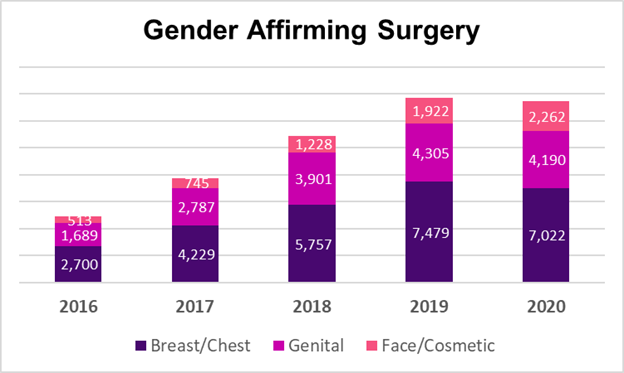Source: Wright, et al JAMA Network Open, August 23, 2023 LINK
Medical coverage for transgender and gender diverse (TGD) plan members is often in the news, and many employers wonder “how common is gender affirming surgery?” Researchers in JAMA Network Open used databases on inpatient and ambulatory surgery to assess frequency of gender affirming surgery, and extrapolated these results to offer national estimates. Researchers found that “top” surgery (mastectomy in trans males) was the most common surgery, and genital surgery and cosmetic surgery were less common. They found that from 2016-2020, gender affirming surgery increased almost three-fold and was far more common in the West and Northeast. They posit that the small decrease in 2020 is likely due to the pandemic.
Most of those getting gender affirming surgery were between 19-30 years of age (52.3%), and few of them (7.7%) were 18 or under. The researchers noted that they could have underestimated procedure numbers to the extent some patients paid out of pocket or had surgery at low volume community hospitals.
Implications for Employers:
- Gender affirming surgical procedures have increased, although remain relatively uncommon.
- The clinical approach to treating gender dysphoria is highly individualized. Many transgender or gender diverse people use gender affirming hormones and have no or limited surgical procedures. Some might only have surgical procedures.
- Transgender people have higher rates of depression, anxiety and suicide, and health plans should provide access to culturally appropriate mental health services.
The Human Rights Campaign Corporate Equality Index references employers’ coverage based on the WPATH (World Professional Association for Transgender Health) Standards of Care Version 8. National insurers have generally incorporated these standards into their plan design. Here’s a link to an explanatory article by my colleague Patricia Toro. MD MPH on these standards.




Suicide amongst youth who identify as trans is extremely rare. Data from the world’s largest clinic for transgender youth, GIDS, spanning 11 years, reveals the following:
• From 2010 to 2020, among 15,032 patients, there were 4 suicide deaths, representing a proportion of 0.03%. This is orders of magnitude smaller than the proportion of transgender adolescents who report attempting suicide when surveyed.
• Two of these suicides occurred among patients on the waiting list, a statistic that is not disproportionate considering the waiting list contributed to nearly half of the total patient-years.
• The estimated annual suicide rate stood at 13 per 100,000 individuals. It’s important to note that this estimate does not account for associated psychological conditions, such as autism, which can heighten the risk of suicide.
https://www.ncbi.nlm.nih.gov/pmc/articles/PMC8888486/